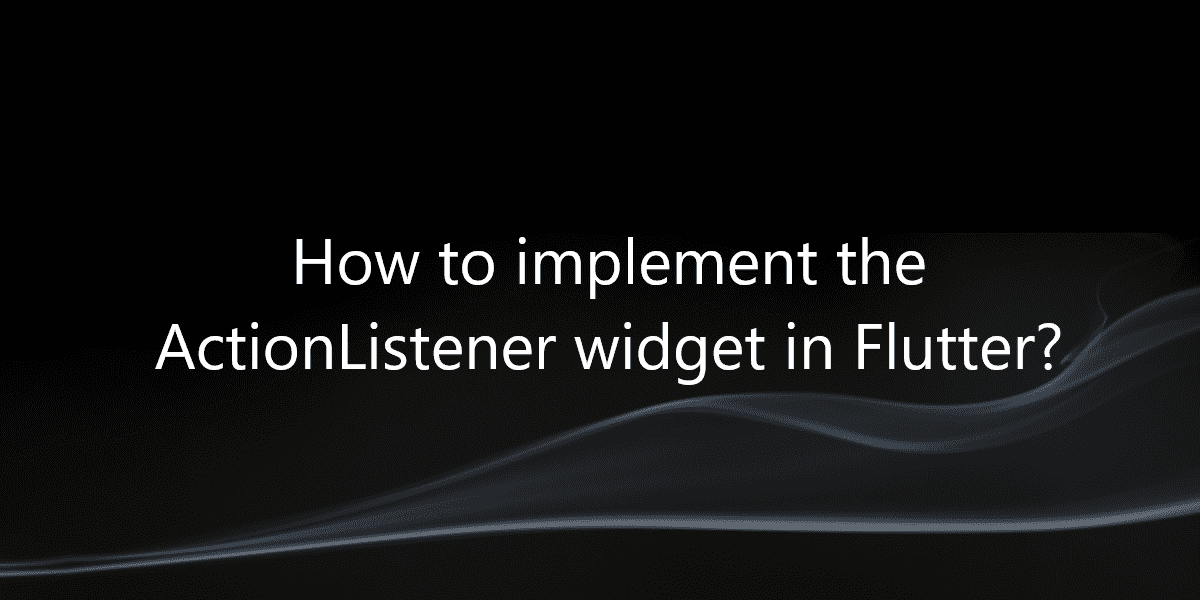How to implement the ActionListener widget in Flutter?
ActionListener is the helper widget. You can use it to remove listeners from the action. So, in this article, we will see how to implement the ActionListener widget in Flutter.
How to implement the ActionListener widget in Flutter?
Listeners of the Action class should use Action.removeActionListener to remove the listener callback when the listener is destroyed. This widget helps with that. It provides a lifetime for the connection between the listener and the action. It also helps to handle the addition and removal of listeners at appropriate locations in the widget’s lifecycle.
If you listen to an Action widget in a widget hierarchy, you should use this widget. If you want to use the action outside the widget context, you need to call removeListener yourself.
Properties:
- Action: The callback is registered with the action.
- Child: Only one child can have this widget. To design multiple children, make the child of this widget a widget with child properties such as rows, columns, stacks, and then expose the child to this widget.
- hashCode: The hashcode for this object.
- key: Controls how a widget replaces another widget in the tree.
- Listener: ActionListenerCallback callback for registering with the action.
- runtimeType: A representation of the runtime type of an object.
Example:
import 'package:flutter/material.dart';
void main() => runApp(const MyApp());
/// This is the main application widget.
class MyApp extends StatelessWidget {
const MyApp({Key? key}) : super(key: key);
static const String _title = 'Flutter Code Sample';
@override
Widget build(BuildContext context) {
return MaterialApp(
title: _title,
home: Scaffold(
appBar: AppBar(title: const Text(_title)),
body: const Center(
child: MyStatefulWidget(),
),
),
);
}
}
class ActionListenerExample extends StatefulWidget {
const ActionListenerExample({Key? key}) : super(key: key);
@override
State<ActionListenerExample> createState() => _ActionListenerExampleState();
}
class _ActionListenerExampleState extends State<ActionListenerExample> {
bool _on = false;
late final MyAction _myAction;
@override
void initState() {
super.initState();
_myAction = MyAction();
}
void _toggleState() {
setState(() {
_on = !_on;
});
}
@override
Widget build(BuildContext context) {
return Row(
crossAxisAlignment: CrossAxisAlignment.center,
mainAxisAlignment: MainAxisAlignment.center,
children: <Widget>[
Padding(
padding: const EdgeInsets.all(8.0),
child: OutlinedButton(
onPressed: _toggleState,
child: Text(_on ? 'Disable' : 'Enable'),
),
),
if (_on)
Padding(
padding: const EdgeInsets.all(8.0),
child: ActionListener(
listener: (Action<Intent> action) {
if (action.intentType == MyIntent) {
ScaffoldMessenger.of(context).showSnackBar(const SnackBar(
content: Text('Action Listener Called'),
));
}
},
action: _myAction,
child: ElevatedButton(
onPressed: () => const ActionDispatcher()
.invokeAction(_myAction, const MyIntent()),
child: const Text('Call Action Listener'),
),
),
),
if (!_on) Container(),
],
);
}
}
class MyAction extends Action<MyIntent> {
@override
void addActionListener(ActionListenerCallback listener) {
super.addActionListener(listener);
print('Action Listener was added');
}
@override
void removeActionListener(ActionListenerCallback listener) {
super.removeActionListener(listener);
print('Action Listener was removed');
}
@override
void invoke(covariant MyIntent intent) {
notifyActionListeners();
}
}
class MyIntent extends Intent {
const MyIntent();
}
/// This is the stateful widget that the main application instantiates.
class MyStatefulWidget extends StatefulWidget {
const MyStatefulWidget({Key? key}) : super(key: key);
@override
State<MyStatefulWidget> createState() => _MyStatefulWidgetState();
}
/// This is the private State class that goes with MyStatefulWidget.
class _MyStatefulWidgetState extends State<MyStatefulWidget> {
@override
Widget build(BuildContext context) {
return const ActionListenerExample();
}
}
Output:
Conclusion:
Thanks for being with us on a Flutter Journey!
So, in this article, we have seen how to implement the ActionListener widget in Flutter. Also, feel free to comment and provide any other suggestions regarding Flutter.
Flutter Agency is our portal Platform dedicated to Flutter Technology and Flutter Developers. Also, the portal is full of cool resources from Flutter like Flutter Widget Guide, Flutter Projects, Code libs and etc.
Flutter Agency is one of the most popular online portals dedicated to Flutter Technology. Daily thousands of unique visitors come to this portal to enhance their knowledge of Flutter.
Contemporary ventures
Recent blog
ready to get started?
Fill out the form below and we will be in touch soon!
"*" indicates required fields














